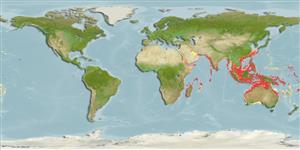Environment: milieu / climate zone / depth range / distribution range
Ecología
marino; salobre asociado a arrecife; oceanodromo (Ref. 51243); rango de profundidad 20 - 200 m (Ref. 28016), usually ? - 60 m (Ref. 90102). Tropical; 27°N - 37°S, 29°E - 152°E
Indo-West Pacific: Red Sea (Ref. 12541) south to the southeastern coast of South Africa and east to New Caledonia and Vanuatu. Recently reported from Tonga (Ref. 53797). Due to a widespread confusion with Sphyraena putnamae and Sphyraena qenie, the exact range is uncertain.
Tamaño / Peso / Age
Maturity: Lm ? range ? - ? cm
Max length : 150 cm TL macho / no sexado; (Ref. 2871); common length : 120 cm TL macho / no sexado; (Ref. 5450); peso máximo publicado: 11.5 kg (Ref. 40637)
Espinas dorsales (total) : 6; Radios blandos dorsales (total) : 9; Espinas anales: 2; Radios blandos anales: 7 - 9. Body with dark bars crossing lateral line, each bar oblique in upper half, but nearly vertical in lower half; caudal fin largely yellowish.
Found near prominent current-swept lagoon or seaward reefs (Ref. 9710); also in bays, estuaries and turbid inner lagoons (Ref. 9768). Diurnal and solitary, although the young form schools. Feeds mainly on fishes but also takes squid. Sold fresh, frozen or dried salted. Reports of ciguatera poisoning need confirmation.
Life cycle and mating behavior
Maturities | Reproducción | Spawnings | Egg(s) | Fecundities | Larva
De Sylva, D.P. and F. Williams, 1986. Sphyraenidae. p. 721-726. In M.M. Smith and P.C. Heemstra (eds.) Smiths' sea fishes. Springer-Verlag, Berlin. (Ref. 5491)
IUCN Red List Status (Ref. 130435)
Threat to humans
Reports of ciguatera poisoning (Ref. 31637)
Human uses
Pesquerías: comercial; pesca deportiva: si
Herramientas
Special reports
Download XML
Fuentes de Internet
Estimates based on models
Preferred temperature (Ref.
123201): 23.6 - 28.5, mean 27.3 °C (based on 442 cells).
Phylogenetic diversity index (Ref.
82804): PD
50 = 0.5000 [Uniqueness, from 0.5 = low to 2.0 = high].
Bayesian length-weight: a=0.00724 (0.00609 - 0.00862), b=2.92 (2.88 - 2.96), in cm total length, based on LWR estimates for this species (Ref.
93245).
Nivel trófico (Ref.
69278): 4.5 ±0.6 se; based on diet studies.
Generation time: 11.0 ( na - na) years. Estimated as median ln(3)/K based on 1
growth studies.
Resiliencia (Ref.
120179): Bajo, población duplicada en un tiempo mínimo de 4.5-14 años (K=0.10).
Fishing Vulnerability (Ref.
59153): Very high vulnerability (75 of 100).
Climate Vulnerability (Ref.
125649): High to very high vulnerability (73 of 100).
Nutrients (Ref.
124155): Calcium = 9.99 [4.90, 24.38] mg/100g; Iron = 0.237 [0.110, 0.480] mg/100g; Protein = 20.4 [18.5, 22.0] %; Omega3 = 0.0926 [, ] g/100g; Selenium = 48.2 [21.0, 111.8] μg/100g; VitaminA = 34.4 [8.7, 183.3] μg/100g; Zinc = 0.458 [0.304, 0.776] mg/100g (wet weight); based on
nutrient studies.
